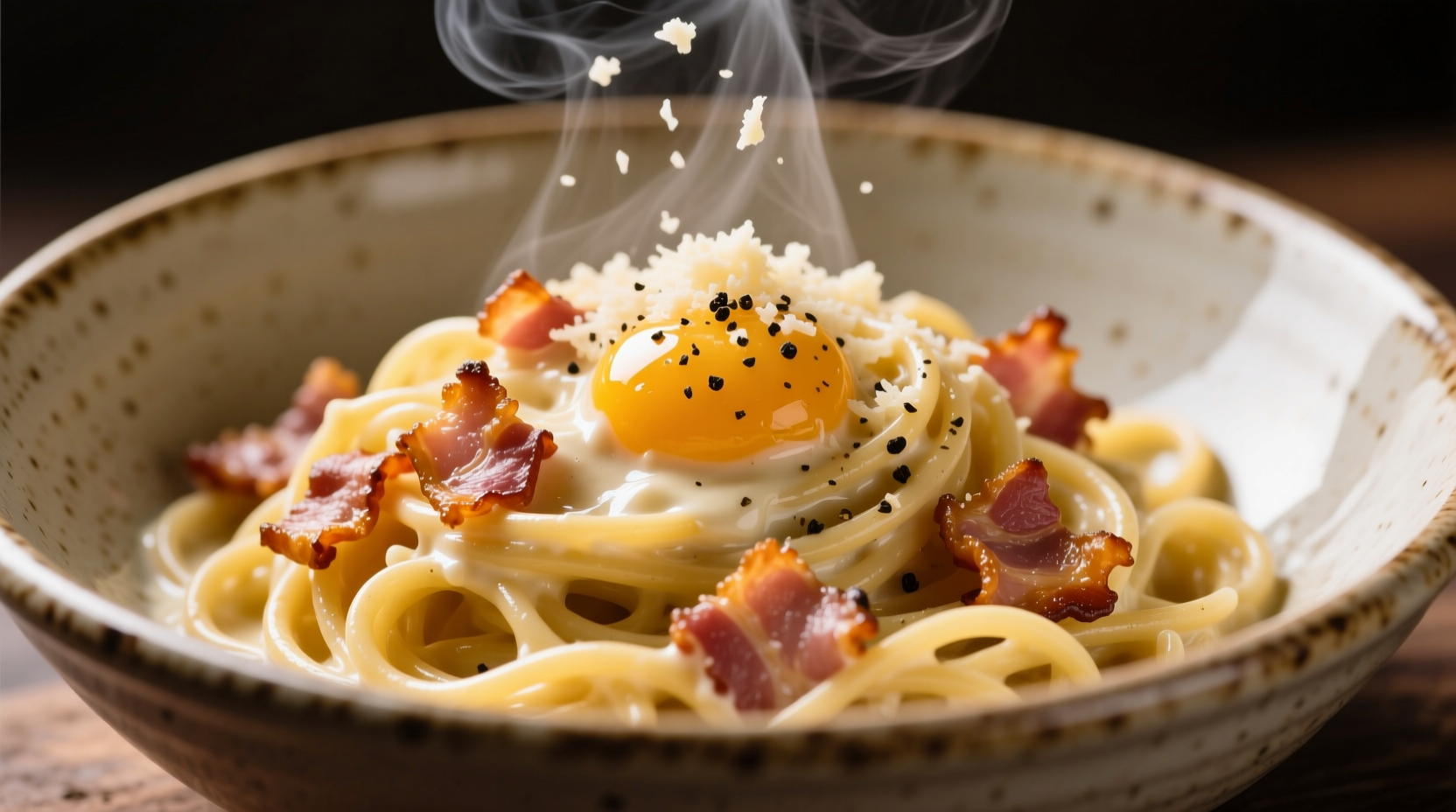The Essential Flavor Components of Authentic Carbonara
When you take your first bite of properly prepared carbonara, you'll experience a complex harmony of flavors that defines Rome's iconic pasta dish. Unlike creamy Alfredo or buttery aglio e olio, carbonara achieves its signature richness through a delicate emulsion of eggs, Pecorino Romano cheese, and rendered guanciale fat—never cream. This traditional Roman preparation creates a sauce that's simultaneously:
- Savory and umami-rich from the cured pork (guanciale)
- Slightly salty with a sharp tang from aged Pecorino Romano
- Subtly peppery with warm, floral notes from freshly cracked black pepper
- Creamy yet light with a silky texture that clings to pasta
- Delicately eggy without overpowering the other elements
Food scientists at the Polytechnic University of Turin have studied carbonara's emulsion process, confirming that the magic happens when tempered egg mixture meets hot pasta—creating a smooth sauce through controlled protein coagulation rather than dairy addition.
Texture: The Unsung Hero of Carbonara's Appeal
What truly distinguishes carbonara from other pasta dishes is its unique texture. The sauce should coat each strand of spaghetti in a thin, luxurious layer that feels:
- Velvety without being heavy or gloppy
- Substantial enough to provide mouthfeel satisfaction
- Moist but not wet or soupy
- Temperature-perfect—warm but not hot enough to scramble the eggs
When executed properly, carbonara should leave your palate feeling satisfied but not weighed down—a delicate balance that explains its enduring popularity since its post-WWII origins.

Authentic Carbonara vs. Common Misconceptions
Many restaurant versions deviate significantly from traditional carbonara, altering the flavor profile. Understanding these differences helps identify authentic preparation:
| Authentic Carbonara | Common Restaurant Variations |
|---|---|
| No cream or milk added | Cream added for 'safety' or richness |
| Guanciale (cured pork cheek) as base | Bacon substituted (different fat composition) |
| Pecorino Romano cheese only | Parmesan or cheese blends used |
| Egg yolks + whole eggs | Only egg yolks or excessive eggs |
| Black pepper integral to flavor | Pepper merely garnish |
According to the Italian National Tourist Board, authentic Roman carbonara contains only four ingredients: spaghetti, guanciale, Pecorino Romano, and black pepper—with eggs serving as the emulsifier rather than a primary flavor.
Why Carbonara Tastes So Distinctive: The Science Behind the Flavor
The unique taste of carbonara emerges from precise chemical interactions during preparation:
- Fat emulsification: Guanciale fat binds with egg proteins to create a stable sauce
- Temperature control: Pasta heat cooks eggs gently without scrambling
- Maillard reaction: Guanciale develops complex flavors during rendering
- Calcium interaction: Cheese calcium binds with egg phospholipids for smooth texture
Culinary researchers at Sapienza University of Rome have documented how traditional preparation creates hundreds of flavor compounds through these interactions—explaining why shortcuts produce fundamentally different taste experiences.
Regional Variations and Their Flavor Impact
While Roman carbonara remains the gold standard, regional variations across Italy create distinct taste profiles:
- Rome (authentic): Sharp Pecorino, rich guanciale, balanced pepper
- Naples variation: Adds garlic for aromatic complexity
- Amatriciana influence: Sometimes includes tomato for subtle sweetness
- Northern Italy: Occasionally substitutes pancetta for guanciale
These variations demonstrate carbonara's evolution while highlighting why the original Roman preparation delivers the purest expression of its signature flavor profile.
How to Identify Authentic Carbonara by Taste
When evaluating carbonara, look for these sensory markers of authenticity:
- First impression: Salty umami from guanciale hits before cheese notes
- Middle palate: Creamy egg-cheese emulsion without dairy heaviness
- Finish: Warm pepper sensation that lingers without burning
- Mouthfeel: Sauce clings to pasta without pooling or separating
- Aroma: Savory pork notes dominate over cheese sharpness
As culinary historian Sophie Dubois explains: "Authentic carbonara should taste like the perfect marriage of Roman countryside ingredients—simple elements transformed through technique into something greater than the sum of its parts."
Perfect Pairings for Carbonara's Flavor Profile
To enhance rather than compete with carbonara's distinctive taste:
- Wine: Crisp white like Frascati or medium-bodied red like Cesanese
- Side: Simple green salad with lemon vinaigrette for palate cleansing
- Accompaniment: Crusty bread for soaking up remaining sauce
- Seasoning: Extra black pepper at table—not additional cheese
Avoid pairing with strongly flavored elements that would overwhelm carbonara's delicate balance. The dish shines brightest when allowed to be the star of the meal.











 浙公网安备
33010002000092号
浙公网安备
33010002000092号 浙B2-20120091-4
浙B2-20120091-4